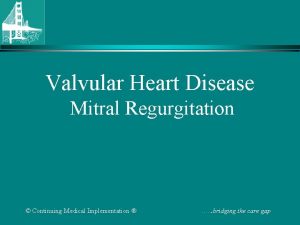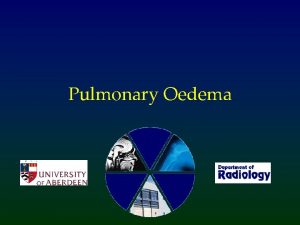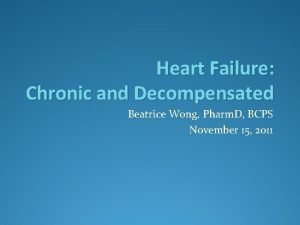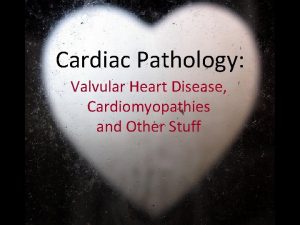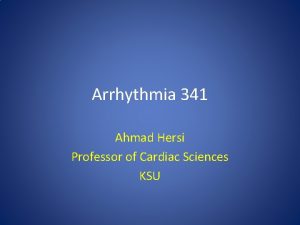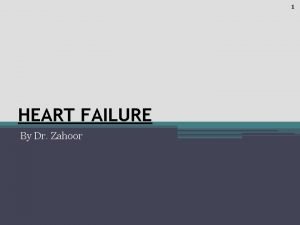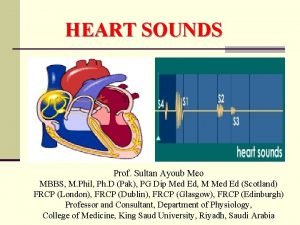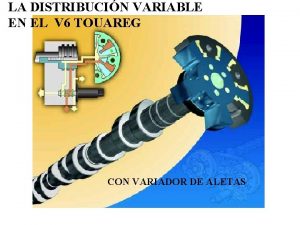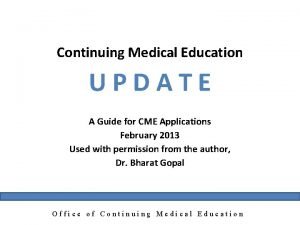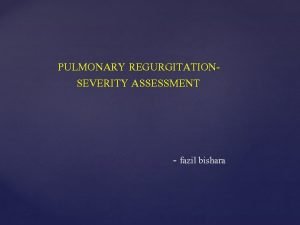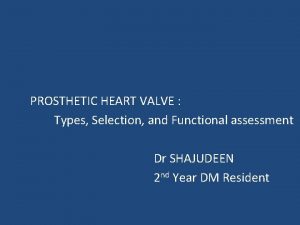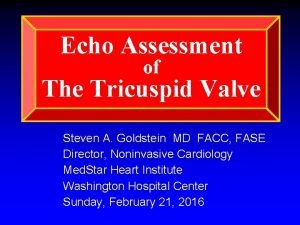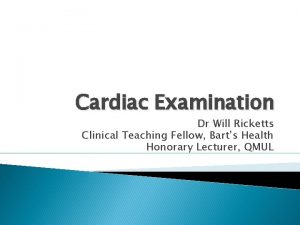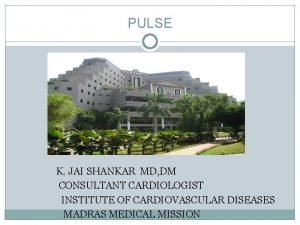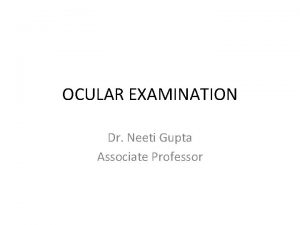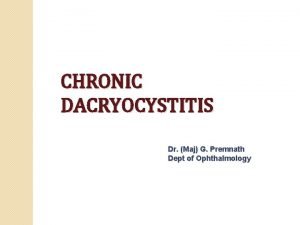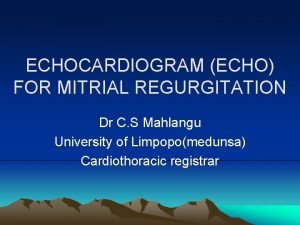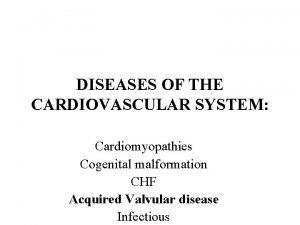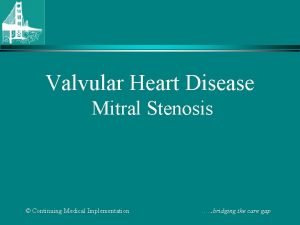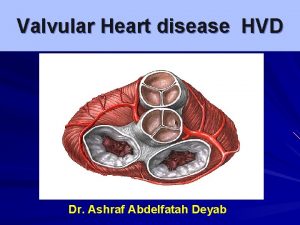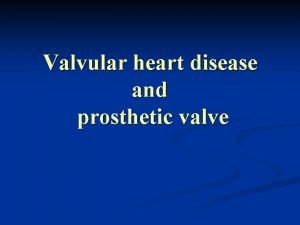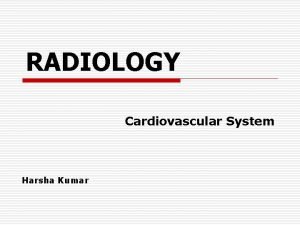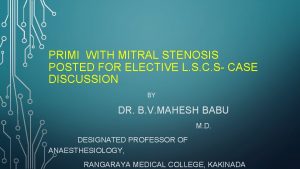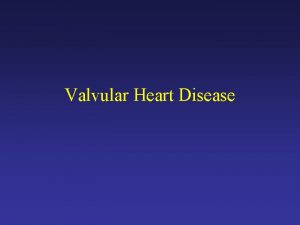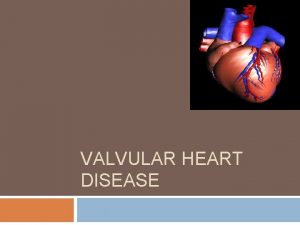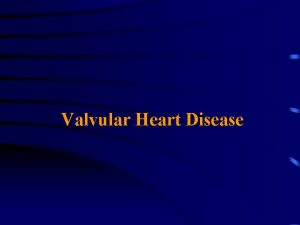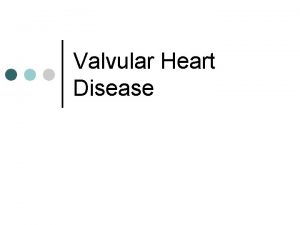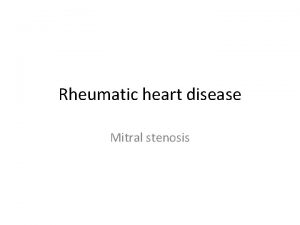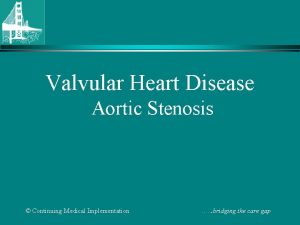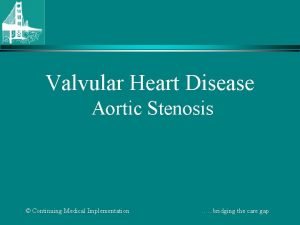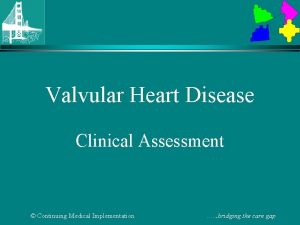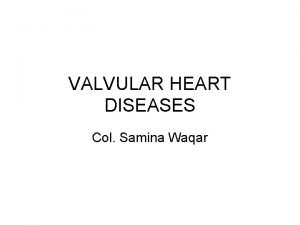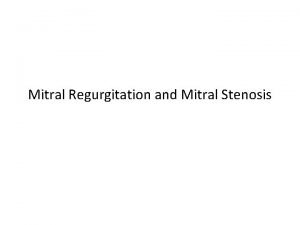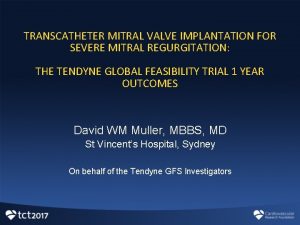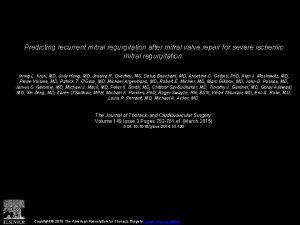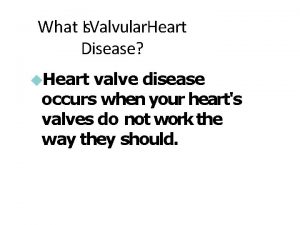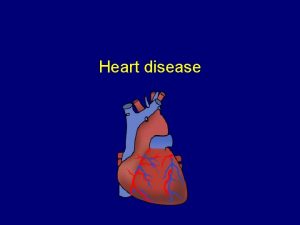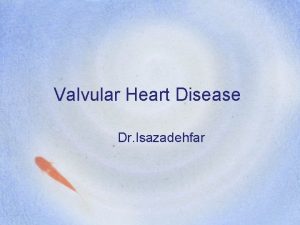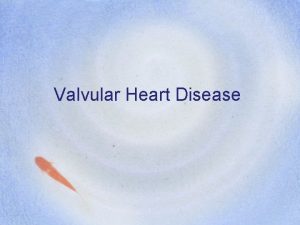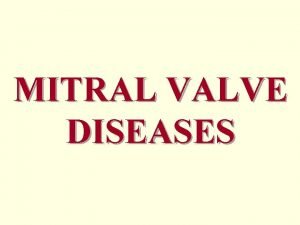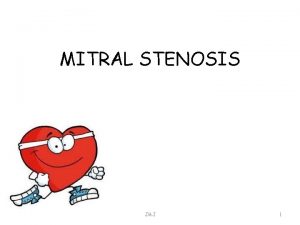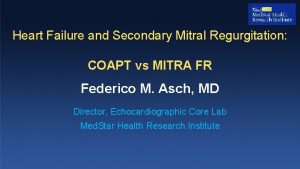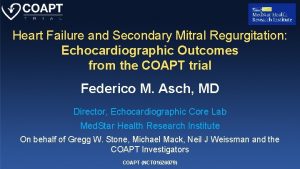Valvular Heart Disease Mitral Regurgitation Continuing Medical Implementation

































- Slides: 33

Valvular Heart Disease Mitral Regurgitation © Continuing Medical Implementation ® …. . . bridging the care gap

Mitral Regurgitation • • • Etiology Symptoms Physical Exam Severity Natural history Timing of Surgery © Continuing Medical Implementation ® …. . . bridging the care gap

An 80 year old woman with increasing dyspnea • Longstanding heart murmur • Increasing dyspnea & fatigue • Recent ER visit Dx CHF © Continuing Medical Implementation ® …. . . bridging the care gap

Mitral Regurgitation: Etiology • Valvular-leaflets – Myxomatous MV Disease – Rheumatic – Endocarditis – Congenital-clefts • Chordae – – Fused/inflammatory Torn/trauma Degenerative IE • Annulus – Calcification, IE (abcess) • Papillary Muscles – CAD (Ischemia, Infarction, Rupture) – HCM – Infiltrative disorders • LV dilatation & functional regurgitation © Continuing Medical Implementation ® …. . . bridging the care gap • Trauma

MR Etiology: Surgical series • • MVP(20 -70%) Ischemia (13 -40%) RHD (3 -40%) Infectious endocarditis(10 -12%) © Continuing Medical Implementation ® …. . . bridging the care gap

MR Pathophysiology • Chronic LV volume overload -» compensatory LVE initially maintaining cardiac output • Decompensation (increased LV wall tension) -» CHF • LVE – » annulus dilation – » increased MR • Backflow – » LAE, Afib, Pulmonary HTN © Continuing Medical Implementation ® …. . . bridging the care gap

MR Symptoms • • • Similar to MS Dyspnea, Orthopnea, PND Fatigue Pulmonary HTN, right sided failure Hemoptysis Systemic embolization in A Fib © Continuing Medical Implementation ® …. . . bridging the care gap

Recognizing Chronic Mitral Regurgitation • Pulse: – brisk, low volume • Apex: – – hyperdynamic laterally displaced palpable S 3 +/- thrill late parasternal lift 2 to LA filling • S 1 soft or normal • S 2 wide split (early A 2) unless LBBB • Murmer-Fixed MR: – pansystolic – loudest apex to axilla – no post extra-systolic accentuation • Murmer-Dynamic MR(MVP) – mid systolic – +/- click – upright • S 3 / flow rumble if severe © Continuing Medical Implementation ® …. . . bridging the care gap

Recognizing Acute Severe Mitral Regurgitation • Acute severe dyspnea, • RV lift CHF & hypotension • TTE/TEE for diagnosis • LV size normal – Chordal or papilllary • LV may/may not be muscle rupture/tear hyperdynamic – Infarction with • Loud S 1 papillary muscle ischaemia or tear • Systolic murmur may/may not be pan-systolic – Infectious endocarditis with leaflet perforation • Inflow/rumble or disruption or chordal • S 3 present-may be only tear abnormality – Flail MV segment © Continuing Medical Implementation ® …. . . bridging the care gap

Comparing AS and MR Systolic Murmurs • Aortic stenosis • Mitral insufficiency • Mitral valve prolapse • Tricuspid insufficiency Diastolic Murmurs • Aortic insufficiency • Mitral stenosis © Continuing Medical Implementation ® …. . . bridging the care gap S 1 S 2 S 1

Assessing Severity of Chronic Mitral Regurgitation Measure the Impact on the LV: • Apical displacement and size • Palpable S 3 • Longer/louder MR murmer (chronic MR) • S 3 intensity/ length of diastolic flow rumble • Wider split S 2 (earlier A 2) unless HPT narrows the split © Continuing Medical Implementation ® …. . . bridging the care gap

Recognizing Mitral Regurgitation • ECG: – LA enlargement – Afib – LVH (50% pts. With severe MR) – RVH (15%) – Combined hypertrophy (5%) • CXR: – LV – LA – pulmonary vascularity – CHF – Ca++ MV/MAC © Continuing Medical Implementation ® …. . . bridging the care gap

MR Echocardiography • Baseline evaluation to identify etiology, quantify severity of MR • Assess and quantify LV function and dimensions • Annual or semi-annual surveillance of LV function, estimated EF and LVESD in asymptomatic severe MR • To establish cardiac status after change in symptoms • Baseline study post MVR or repair © Continuing Medical Implementation ® …. . . bridging the care gap

MR Echocardiography • Etiology: – – flail leaflets (chord/pap rupture) thick (RHD) post mvt of leaflets (MVP) vegetations(IE) • Severity: – regurgitant volume/fraction/orifice area – LV systolic function – increased LV/LA size, EF © Continuing Medical Implementation ® …. . . bridging the care gap

MR Echo/Doppler © Continuing Medical Implementation ® …. . . bridging the care gap

MR Pressure Tracing © Continuing Medical Implementation ® …. . . bridging the care gap

MR Stages LV size and function defined by echo • Stage 1 -compensated: – End-diastolic dimension less 63 mm, ESD less 42 mm – EF more than 60 • Stage 2 -transitional – EDD 65 -68 mm, ESD 44 -45 mm, EF 53 -57 • Stage 3 -decompensated – EDD more than 70 mm, ESD more than 45 mm, EF less than 50 © Continuing Medical Implementation ® …. . . bridging the care gap

Echo Indicators for Valve Replacement in Asymptomatic Aortic & Mitral Regurgitation Type of Regurgitation LVESD mm EF % FS Aortic > 55 <0. 27 Mitral > 45 < 60 < 0. 32 © Continuing Medical Implementation ® …. . . bridging the care gap

RECOMMENDED FREQUENCY OF ECHOCARDIOGRAPHY IN PATIENTS WITH CHRONIC MITRAL REGURGITATION AND PRIMARY MITRAL-VALVE DISEASE. SEVERITY OF MITRAL REGURGITATION LEFT VENTRICULAR FUNCTION* FREQUENCY OF ECHOCARDIOGRAPHIC FOLLOW-UP Mild Normal ESD and EF Every 5 yr Moderate Normal ESD and EF Every 1 – 2 yr Moderate ESD >40 mm or EF <0. 65 Annually Severe Normal ESD and EF Annually Severe ESD >40 mm or EF <0. 65 Every 6 mo *ESD denotes end-systolic dimension and EF ejection fraction. Otto C. M. NEJM 345: 10. © Continuing Medical Implementation ® …. . . bridging the care gap

© Continuing Medical Implementation ® …. . . bridging the care gap

Mitral Valve Surgery • Only effective treatment is valve repair/replacement • Optimal timing determined: – Presence/absence of symptoms – Functional state of ventricle – Feasability of valve repair – Presence of Afib/PHTN – Preference/expectations of patient © Continuing Medical Implementation ® …. . . bridging the care gap

Surgical Therapy - Timing • Surgery reduces morbidity and mortality from severe MR but exposes patient to risk of surgery and prosthetic valve • Surgery should be performed before onset of severe symptoms or development of LV contractile dysfunction © Continuing Medical Implementation ® …. . . bridging the care gap

Symptoms • Class III or IV symptoms (even if transient) always indicate need for surgery • Class II symptoms indicate need for surgery in patients with repairable valves • ETT may reveal concealed symptoms © Continuing Medical Implementation ® …. . . bridging the care gap

Ejection Fraction (LVEF) • Strongest predictor of outcome following surgery • Should be assessed quantitatively – MUGA or Echo • Surgery indicated if LVEF is below normal (60%) • If EF normal, follow every 6 to 12 months • If EF <30%, medical management (valve repair experimental in this setting) © Continuing Medical Implementation ® …. . . bridging the care gap

Load-Independent Measures of LV Function • Complex measurements: – – LV d. P/d. T End-systolic stress-strain Myocardial Elastance Peak systolic pressure/end-systolic volume • End-systolic diameter – LVIDs >45 predicts poor outcome • End-systolic volume index – ESVI >50 cc/m 2 predicts poor outcome © Continuing Medical Implementation ® …. . . bridging the care gap

Other Indications • • Flail mitral leaflet Left atrial dimension >45 mm Paroxysmal atrial fibrillation Pulmonary hypertension © Continuing Medical Implementation ® …. . . bridging the care gap

Mitral Regurgitation ACC/AHA recommendations Surgery Recommended in patients who are • Symptomatic • Asymptomatic with – Any LV dysfunction – Atrial fibrillation – Pulmonary hypertension – Reparable valves – Recurrent VT © Continuing Medical Implementation ® …. . . bridging the care gap

Indications for Surgery Isolated, Severe Chronic MR • Definite (major criteria): – NYHA Class III or IV heart failure (any duration) – EF <60% – EF >60% but decreasing on serial measurements – LVIDs >45 mm – ESVI >50 cc/m 2 © Continuing Medical Implementation ® …. . . bridging the care gap

Indications for Surgery Isolated, Severe Chronic MR • Emerging (minor criteria): – Any symptoms of heart failure or sub optimal exercise tolerance test – Flail mitral leaflet – Left atrial diameter >45 mm – Paroxysmal atrial fibrillation – Abnormal exercise end-systolic volume index or ejection fraction © Continuing Medical Implementation ® …. . . bridging the care gap

MV Repair vs. Replacement • • Lower operative mortality Better late outcome Curative Avoids anticoagulation unless atrial fibrillation • Open Afib ablation © Continuing Medical Implementation ® …. . . bridging the care gap

MV Repair vs. Replacement (2) • Valve replacement: • Valve repair – Mortality 2 -7% – Mortality 2 -3% – Anti-coagulation – No anticoagulation – Decreased LVEF (unless Afib) – Preservation of LVEF • Tissue prosthetic valve degeneration • Valve repair always preferable • Mechanical prosthetic – Feasible in 70 -90% of valve dysfunction/ patients thrombosis © Continuing Medical Implementation ® …. . . bridging the care gap

Mitral Valve Replacement Other Issues • Mechanical valve – thromboembolism, bleed from anticoagulation • Bioprosthetic valve– limited durability (degeneration) • Chordal/subvalvular apparatus preservation – EF preop/postop 60% to 36% VS 63% to 61% in a comparative study © Continuing Medical Implementation ® …. . . bridging the care gap

Acknowledgment • Some slides adapted from Cardiology Rounds presentation by Stephane Moffett – R 1 Anesthesia © Continuing Medical Implementation ® …. . . bridging the care gap
 Mitral regurgitation symptoms
Mitral regurgitation symptoms Mitral stenosis severity
Mitral stenosis severity Upper lobe venous diversion
Upper lobe venous diversion Dopamine uses
Dopamine uses Pathophysiology of valvular heart disease
Pathophysiology of valvular heart disease Right sided heart failure
Right sided heart failure Pathophysiology of valvular heart disease
Pathophysiology of valvular heart disease Causes of valvular heart disease
Causes of valvular heart disease Site:slidetodoc.com
Site:slidetodoc.com Ejection systolic murmur causes
Ejection systolic murmur causes Aortic regurgitation murmur
Aortic regurgitation murmur Traslape valvular
Traslape valvular Continuing medical education
Continuing medical education Aafp metric
Aafp metric Continuing medical education
Continuing medical education Primary tricuspid regurgitation
Primary tricuspid regurgitation Jet fazil
Jet fazil Pannus
Pannus Tricuspid valve leaflets tee
Tricuspid valve leaflets tee Pulmonic regurgitation murmur
Pulmonic regurgitation murmur Dicrotic pulse
Dicrotic pulse Chemosis
Chemosis Stages of chronic dacryocystitis
Stages of chronic dacryocystitis Mitrial
Mitrial Tricuspid valve
Tricuspid valve Bharathi viswanathan
Bharathi viswanathan L
L Mitral facies
Mitral facies S2 os gap
S2 os gap Define mitral stenosis
Define mitral stenosis Rvh cxr
Rvh cxr Mitral facies
Mitral facies Atheromatous thoracic aorta
Atheromatous thoracic aorta Mitral stenosis echo guidelines
Mitral stenosis echo guidelines
